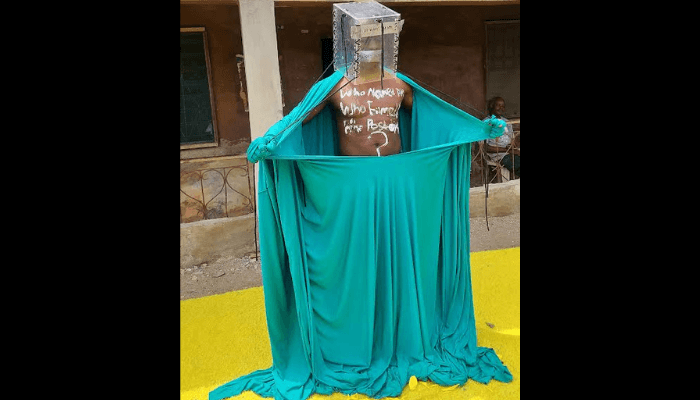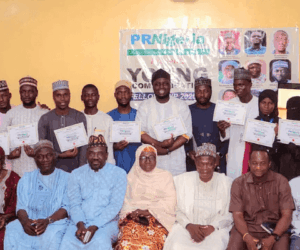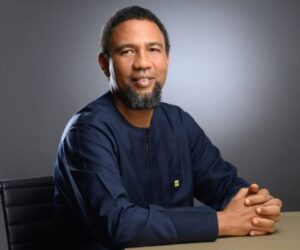While residents of Ogbere Street in Bariga, Lagos, were still observing the Thursday sanitation on August 14, 2025, which lasted until 10:00 am, their obedience and wait were hugely rewarded.
Yes, by an impromptu, colorfully and enthralling open-street performance by Yusuf Durodola, a multi-disciplinary contemporary Nigerian artist.
The lucky residents and neighbourhood of the riverine community, bordering the Lagos Lagoon, were treated to a world-class show from the creative juices of Durodola, who is vast in such people-oriented, yet issue-based or advocacy theatrical performances.
The performance, Ara Bàntù, Orí Bíntín, a Yoruba phrase, which literally translates as “Big Body, Small Head”, was staged from a yellow rug on Ogbere Street, in Bariga.
It was delightful to watch the artist dress up in his performance paraphernalia, amid the residents watching, and some walking and going about their business.
Also, part of the performance paraphernalia is two yellow stones, which the artist said represent the pillars of a nation.
Dressed in a green overflowing gown, transparent glass mask with a question: Must I see what you see? and many yellow balloons with inscriptions on a few of them, mouth covered with a cellophane with an inscription: ‘I am a key in your mind’, Durodola was set to enthrall. He did just that with the exciting performance that lasted close to an hour.
He commenced his drama from Ogbere Street, moving from the quiet street with admirable ease, displaying signs with two drumming sticks in his hands, often stopping momentarily and spreading his overflowing gown to its full length.
As the performance progresses to Ilaje Road, which ends at the new jetty built by the Lagos State government by the Third Mainland Bridge on the Lagos Lagoon, the artist keeps heightening the excitement for the residents, and especially the passersby, who are more intrigued by the unique performance.
Some called it ‘Egungun’ masquerade in Yoruba, some argued that it did not look like one, others said that skit makers were at work, but the majority enjoyed the show.
But that mattered most for the performing artist.
The colourful display on Ilaje Road saw the artist moving further up on the road beyond the Abibatu Mogaji Primary Health Centre, Bariga, before returning to the starting point.
But the journey back to Ogbere Street was more majestic as Durodola, who is actually a masquerade for the viewers, made his way back with more thrills.
The momentary stops on the way, sign displays, intentional spreading of his green gown, playing with the balloons, and yet no speech, were all spectacular.
On getting to the yellow rug on Ogbere Street, his starting point, which also turned out to be his finishing point, the viewers witnessed a climax of the performance as Durodola took time to burst all the yellow balloons, one after the other.
The balloons were talking louder with inscriptions such as: ‘Who is the law meant for? Curate your character!
He went further to remove the transparent mask, mouth covering, and in an exciting manner, tore the gown halfway to reveal the inscriptions on his bare chest: Who naked me? Who filmed me? Who posted me?
That was a point some started clapping for him, even the camera people had to pause to do the same.
Truly, Ara Bàntù, Orí Bíntín — “Big Body, Small Head” — stages the disequilibrium born when strength eclipses vision, when capacity to act swells beyond the capacity to discern. According to Durodola, the above is not merely a metaphor of anatomy but of culture, governance, and identity. In the performance, he explained that the big body becomes a symbol of amplified presence, excessive appetite, and unchecked force, while the small head becomes the sign of diminished foresight, eroded ethics, and the collapse of reflective thinking.
“Through a dramaturgy of fragmented dialogue, charged silences, symbolic movement, and ritual gesture, the work draws from the Yoruba warning: without the guidance of the head, the body’s power is a danger to itself.
“It is the story of might without moral compass, of a community whose external splendour masks an inner decay,” he said.
However, Durodola insisted that this imbalance finds resonance in the ethics of public exposure in today’s digital age.
Relating the performance to current issues in the Nigerian society today, he noted that the Yoruba proverb, “Òré mi ló jù tí, ojú ò tí mi; ìwọ gangan ni o ló jù tí” (“When your friend is shamed and you feel nothing, you are the one truly without honour”) anchors the performance’s moral inquiry.
Who decides what is captured, archived, and displayed? Who becomes the custodian of another’s disgrace? Must every moment — every stumble, every vulnerability — be surrendered to the voracious appetite of the crowd? He queried.
The above queries were also captured at the end of his performance with the inscriptions on his bare chest: Who naked me? Who filmed me? Who posted me?
The questions begging for answers tackled the manner in which a Nigerian lady was treated by an airline, which many condemned.
For the artist, the performance queries the unbecoming actions of some overzealous people, who do not consider society or people’s interests.
For the artist, those who naked the air passenger, those who filmed her nakedness and those who had the guts to post the video, which has gone viral, are culpable and have shamed all and not just the lady by their unsolicited actions, he argued.
Speaking further, he noted that in staging the above questions, Ara Bàntù, Orí Bíntín, does not simply lament; “it challenges. It asks the audience to confront their complicity in a culture that celebrates spectacle but neglects empathy, that prizes exposure over discretion, and that mistakes noise for relevance”.
Moreover, the work becomes a ritual of reckoning — a call to recalibrate the scale between muscle and mind, between presence and purpose. “It pleads for a return to iwa (character) as the measure of greatness, for the restoration of honour as a shared responsibility, and for the safeguarding of our collective dignity from the trivialising flood of the digital gaze,” he noted.
Another highlight of the performance was a critical dialogue with Segun Adefila, founder, Crown Troupe of Africa.
As expected, Adefila, a multidisciplinary artist, renowned choreographer, actor, singer, director and performance artist, engaged Durodola in a hard dialogue session, asking all the questions and getting all the answers.
In the summary of his answers, Durodola noted that society should not be allowed to degenerate so low to celebrate spectacle over empathy, exposure over discretion, and that mistakes noise for relevance.
In the case of the Ibom Air female passenger, he noted that the shame to her is a shame to all, as Nigeria is the topic, and such issues keep shaking the pillar of the nation.
On his part, Adefila commended Durodola for the bold performance that tasks Nigerians on values and challenges the society to sit up.
“As artists, our job is not only to entertain people, but also to use our craft to correct ills in society. We cannot afford to keep quiet when we have all it takes to change things.
“My brother Durodola has done just that with this beautiful and relatable performance,” Adefila said.
Well, Durodola has more to offer from the stable of his creative ingenuity and hopes to step up the advocacy for sane society, justice and equity through art.









